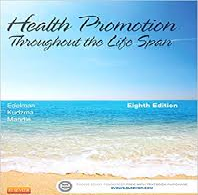Health Promotion Throughout the Lifespan Order Instructions: Answer the following questions:

• 1- Identify and describe the techniques the RN performs during a physical examination.
• 2- Identify the components of a general survey.
• 3- Select an adult and a pediatric developmental age group. Compare and contrast the approach the RN would use to conduct the health history and physical examination. Include a minimum of three techniques the RN would use and explain why each is effective for the developmental age. Base your initial paper on your readings and research on this topic.
Required Textbooks and chapters to use for this paper:
Pillitteri, Adele. (2013). Maternal and Child Health Nursing (7th ed.) Philadelphia; Lippincott, Williams, and Wilkins.
Treas, L. & Wilkinson, J, (2014). Basic nursing: concepts, skills & reasoning. Philadelphia; F. A. Davis, Company.
Nursing Diagnosis
• Use your chosen Nursing Diagnosis Guidebook to review the nursing diagnoses specific to the content covered in this module.
Maternal and child health nursing**
• Chapter 28: Principles of Growth and Development (focus on infant through adolescent)
• Chapter 34: Child Health Assessment (section on Physical Assessment)
• Chapter 37: Nursing Care of Family When a Child Needs Diagnostic of Therapeutic Modalities (section on Vital Signs)
Basic nursing: concepts, skills & reasoning88
• Chapter 8: Theory, Research, & Evidence-Based Practice (section on Maslow)
• Chapter 11: Experiencing Health & Illness
• Chapter 19: Vital Signs
• Chapter 21: Physical Assessment
• Chapter 27: Health Promotion
Web-Based and Other Professional Resources:
• Access to Health Services (2014)**
• Code of ethics for nurses (2015)**
• Pre-licensure KSAs (2014)**
• Hospital: 2016 National Patient Safety Goals (2015)**
Health Promotion Throughout the Lifespan Sample Answer
HEALTH PROMOTION THROUGHOUT THE LIFESPAN
Physical assessment is essential as it helps in the examination of an individual’s health by looking at all aspects in a systematic manner. Various tools of the physical exam, health history, and professional skills are utilized during the physical assessment. There are various steps used by the RN to conduct the physical assessment in an organized and logical sequence. Medical history assessment by the RN is essential before performing other techniques. One of the techniques is inspection which involves systematic visual examination of the patient (Treas & Wilkinson, 2014). Palpation is the second technique used by the RN which involves using the sense of touch to carry out the assessment e.g. for pain, pulse rate, vibration, and temperature. Percussion is the other technique where the body is directly or indirectly struck to elicit sound, but the technique is important at a limited capacity. Auscultation is the other technique which is used to identify the abnormal or normal breath in a patient. There are four components of the general survey which include behavior, physical appearance, mobility, and body structure. While conducting the general survey, the focus would be given to the patient’s level of consciousness, facial expression, personal hygiene, weight and nutritional status which would be based on the four components (Treas & Wilkinson, 2014).
There are different approaches adopted by the RN nurse while conducting the assessment of adult and developmental age group. In both age groups, the RN would ensure systematic inspection of the patient is carried out while also ensuring social, emotional and physical evaluation is done. While assessing the developmental age group, the RN would consider inspection, autonomy, consent and confidentiality techniques as major issues during the evaluation (Treas & Wilknson, 2014). In this case, the developmental assessment is more focused on thus making the approach a diverse and broad component of assessment. The RN would adopt a different approach while carrying out a physical examination of the adult age group since their evaluation is less complex compared to that of developmental age. The auscultation process, assessment of behavior and inspection would be essential while assessing the adults. The main focus while assessing the adult age group is the identification of lifestyle behaviors as well as evaluating nutritional status and specific screening (Treas & Wilkinson, 2014). In a nutshell, the adoption of the right techniques of physical assessment would be a proper initial step of the treatment process.
Health Promotion Throughout the Lifespan Reference
Treas, L. & Wilkinson, J, (2014). Basic nursing: concepts, skills & reasoning. Philadelphia; F. A. Davis, Company.




